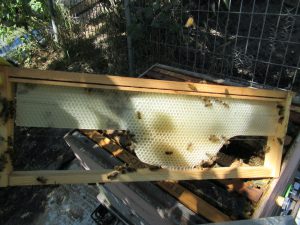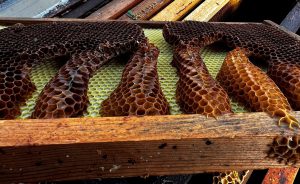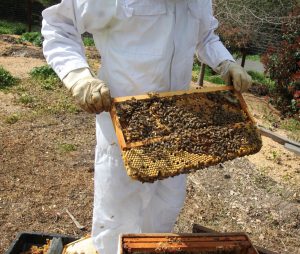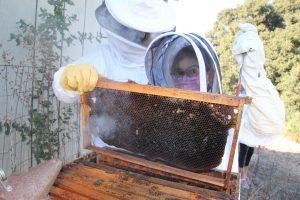By: Ettamarie Peterson
Surely you have heard the saying about asking ten beekeepers and getting eleven different answers. Well, it is true because beekeepers are constantly having to choose what methods and what equipment they want to use. We are, for the most part, rather flexible and willing to try various things. There are some old timers who will give you firm advice, but I bet if you questioned them, they would admit that isn’t what they did when they first started beekeeping. For one reason or another they changed techniques and/or equipment. Many read articles in Bee Culture Magazine (and/or other journals) that inspired them. Some read books that encouraged them to try something new. Others found their equipment wearing out and looked for replacements.
My first example of choices we beekeepers very often make is what to put in deep and medium frames. It can be overwhelming, especially for a beginner. Very often, the beginning beekeeper will buy a complete “starter hive” that comes with the plastic foundations in plastic frames because they are the easiest of all. You don’t have to figure out how to use them. They are what could be called “no brainers”.

Frame with a partial piece of beeswax foundation and wires.
The all-plastic frames with the foundation do have their drawbacks the beekeepers will discover. One major problem with these plastic foundations is sometimes the bees do not properly adhere the comb to the plastic. The comb can be hung like a curtain, just a little bit away from the plastic. Sometimes, just to be creative maybe, the bees will put some on the plastic and ignore it in other places. When this happens on brood frames you cannot see all the brood because some is hidden. Of course, the queen also likes to hide behind these “curtains” too making it difficult to tell which frame she is on. When they make these “curtains” on honey frames all you can do to harvest the honey is carefully remove them and either crush the comb or try to make cut comb honey. Often the bees will draw the comb correctly if you take time to coat the plastic foundation with wax, but that defeats the idea that they are time saving. You can pay extra and order extra heavily waxed plastic foundations. Other times, the manufacturers suggest spraying them with sugar water before using them. This is fine if you want to mess around with spraying sugar water on foundation and hope it helps.
The next drawback with plastic frames is sometimes the plastic can become brittle and your hive tool breaks them while you are attempting to lift them out. You can pay more for extra sturdy frames. The plastic foundation cannot be put into a solar wax melter even if it is in a wooden frame. It will be warped and useless from the heat. There’s really no way to sterilize these plastic frames and/or foundations. If you have foul brood, you cannot burn them either!
You can choose to use plastic foundation in wood frames if the frames have both top and bottom grooves. They are easily popped in. There are little triangle pieces in the lower corners you break off before inserting them. These are so the bees move more easily from one frame to another. The advantage to having wood frames is that the plastic foundation can be popped out to clean the frame completely. I use a propane torch to clean and sanitize the wood parts of my bee equipment. The torch should not be used on anything plastic! I have used a steam cleaner on plastic, but it is time-consuming work.

Plastic foundation that the bees did not use correctly.
Your next choice might be another easy foundation. It would be real beeswax but pre-wired with vertical wires. These require a bit more knowledge of wooden frame choices. The frames should have top and bottom grooves for the foundation to sit in. Many bottom bars do not have that groove so be sure to order the correct ones. Your side bars do not have to have the pre-drilled holes either. As a matter of fact, it is best that they do not. The holes are for threading wires and the wax moths love to use them for their brood. There are different choices in pre-wired frames. Some have longer wires with hooks you place under a thin piece of wood on the top bar. Not all top bars have that thin strip, so you must be sure you have that when you buy the top bars. The top bars with the strip are referred to in the catalogs as “wedge top bars”. You cannot change the size of these foundations, so be sure you order the correct size. Also, you cannot use them for cut comb honey. If for some reason the bees get creative in drawing them out, you might have some problem when uncapping the “wonky” combs. This usually happens if you do not space your frames properly in the boxes. That space is important for getting the bees to draw out combs neatly.
The advantages to the all-in-one foundation that are a plastic frame with a permanent plastic foundation, is that wax moths might feast on the old brood comb, but do not injure the plastic. If you use wood frames with plastic foundation, the wax moths can damage the wood but not the plastic. The other thing that destroys wood is rodents. They will chew the wax and the wood but not plastic parts.

Short frame with plastic foundation put into a deep box. You can see all the capped drone brood!
Another choice is just sheets of stamped beeswax that you put in wired frames. You will need to buy side bars that have the holes pre-drilled, unless you don’t mind drilling little holes in the side bars. The holes work better if you have the brass gromets to put in them for strength. These gromets are sold in little bags. A gromet tool helps to put them securely into the holes on the outer side of the side bars. The first time you wire your frames it would be wise to either watch a video or have a mentor work with you. There are frame wiring boards you can buy or make yourself. The frames sit in the board. Your spool of wire can be attached to the board or on its own holder. You also need an embedding tool. I find pre-warming the foundation with a cheap hair dryer is important if the wax is cool because it breaks easily. Getting just the right pressure when embedding the wax into the wire takes practice. One thing I like about the un-wired foundation is that you can use half or even a third in the wired frames and the bees draw out the rest. If you have purchased a box of deep sized foundation, they can be cut in half and used in the medium frames. One disadvantage to using just partial size wax foundation in honey frames is that they can easily “blow out” in the electric honey extractor.
The last choice is the cheapest of all. Don’t put any foundation in! Use just a starter strip, wax foundation or tongue depressors, aka craft sticks, firmly placed in the top bar. When you do not use foundation, you really should wire your frames or use barbecue skewers either vertically or horizontally. These keep the drawn comb from falling out when you lift the frames during a hive inspection. I discovered this one day when helping a friend do a hive inspection. It was a warm day. I lifted a frame out of his hive and tipped it slightly. The drawn comb almost fell out of the frame because the bees had not attached it securely to the frame. Luckily, we saw what was happening and prevented a mess! These foundationless combs do blow out easily in the honey extractor, so they are best used for brood rearing or crushed honey comb.
It is possible to mix foundations in the bee boxes. I have often mixed no foundation frames with every other frame with foundation. On occasion, you can put a short frame in a deep box, too. The bees generally draw drone comb attached to the bottom board. That drone brood can be cut off to get rid of mites. I accidentally discovered this one time and my 4-H beekeepers had fun digging out drone pupae and seeing all the mites! Don’t be afraid to try different techniques. I tell people when they ask advice to find what they are most comfortable doing. If you find something that makes you and your bees happy, tell your fellow beekeepers what you did.

This frame had only wires. You can see how the wires are supporting the comb. The beekeeper is a young 4-H girl getting help from her two sisters, one using a smoker (bottom left you can see the smoker) and the other helping her lift the frame.
Here in California, we have had prolonged droughts so beekeepers are finding they must feed their bees. There are several choices of feeders available. Each one has pluses and minuses, so you have more decisions to make. The prices will vary.
The most simple and cheapest feeder is the Boardman entrance feeder. It is a little holder that slides under the entrance and has an opening on the inside of the hive. They come in plastic, wood, metal or a combination of wood and metal. They are designed to hold a canning jar with a narrow opening and a lid with small holes punched in it. They are easily filled without disturbing the bees. One advantage is that you can easily see how much sugar water is in them and how quickly the bees are using the feed. They are not recommended for Winter use as the bees must break cluster and go down to the entrance to drink. They also seem to attract ants very quickly, so the beekeeper needs to make sure there is an ant barrier before using them. Another disadvantage is that if the jar is too big, it won’t fit on the landing board, so you do have to fill these more often.
There are several in-hive feeders that go in place of a frame. The main advantage to these is that they do not attract ants or yellow jackets. If you must get into them in “robbing season”, that is a problem. You should cover the other frames while filling the feeder. The disadvantages are you cannot tell how much food is in them; you must disturb the colony to get to them and some designs need floats such as corks or they drown the bees. Some are better designed and do not drown the bees. It appears there are more deep box sized feeders available, but some bee supply stores do have 6¼” sized ones that hold a gallon and fit in medium boxes. The largest sized ones can hold almost two gallons.
Top feeders have the advantage of being very easy to get to without disturbing the bees. Some are even designed so the bees cannot fly out of them when you take the cover off. That design is the one I prefer because the bees cannot get into the holding trays. The ones the bees can get into need to have floats or the bees drown. Also, I have seen bees build comb in them when beekeepers feed the bees a lot and don’t monitor the space when it is empty. The top feeders that are plastic inserts designed to put in empty medium boxes have a problem. The undersides of these inserts have a lot of space that bees seem to like to fill with honey comb. They should have a screen over this space. I have tried this with some I was given. The manufacturers could easily redesign them.
There are other hive top feeders that are containers that fit into an inner cover with a hole cut out. You put an empty box over them and then put the outer cover on top. They can be designed to hold jars or there are some that look something like an angel food cake pan with a cover. I bought one in Ireland that I really like but have not found one like it in the USA.
Smokers come in a variety of styles and prices. Some are small and others are quite large. If you are a hobby beekeeper and have just one or two hives, you really don’t need a huge one. A smoker should be kept in a metal bucket, so the smaller ones are often a better choice. You have choices of what kind of protection you have around the smoker. The guards around the smoker are important to protect you from burning yourself and anything you might set near it. The price difference is not much so do spring for the extra cost to get the guard. The bellows are made of wood and leather or of plastic. There are replacement bellows for most smokers. Check before buying. You can buy various fuels for your smoker. I prefer to use dried horse manure as it is freely given to me by my two ponies. Believe it or not, the dried manure does not smell bad! You will need a stopper to put into the smoker. I find the corks from wine bottles need to be trimmed a bit to fit in the smoker. The corks from many brands of olive oil are even nicer because they have a little holder on the top and fit well with no trimming. If you don’t drink wine nor use olive oil, check with friends who do. People love to help beekeepers!
Before buying new equipment, visit other beekeepers’ apiaries and ask to see what they are using. It is best if you can see into other hives to see how the bees are using the equipment. If this is not possible, go to bee conferences, bee supply stores or peruse catalogs and/or bee supply companies to look at what’s available. If you are at a vendor’s stand, chat with the vendor and other beekeepers around. There are lots of beekeeping videos on the internet these days. Look at more than one to compare techniques. When you are buying equipment ask yourself how I will keep these sanitary, how can I dispose of them if they get infected with foulbrood, how long do these things last and any other things you think are important to your time, budget and beekeeping practices.
About Ettamarie Peterson:
Ettamarie Peterson has been keeping a few bee colonies on her small farm in Northern California for almost thirty years. She is the editor of the Sonoma County Beekeepers Association monthly newsletter and the Liberty 4-H Bee Project leader. She is the mother of three, grandmother of eight and great grandmother of nine children. Her favorite thing to do is catch swarms to share with her 4-H beekeepers and keep a few for herself.








